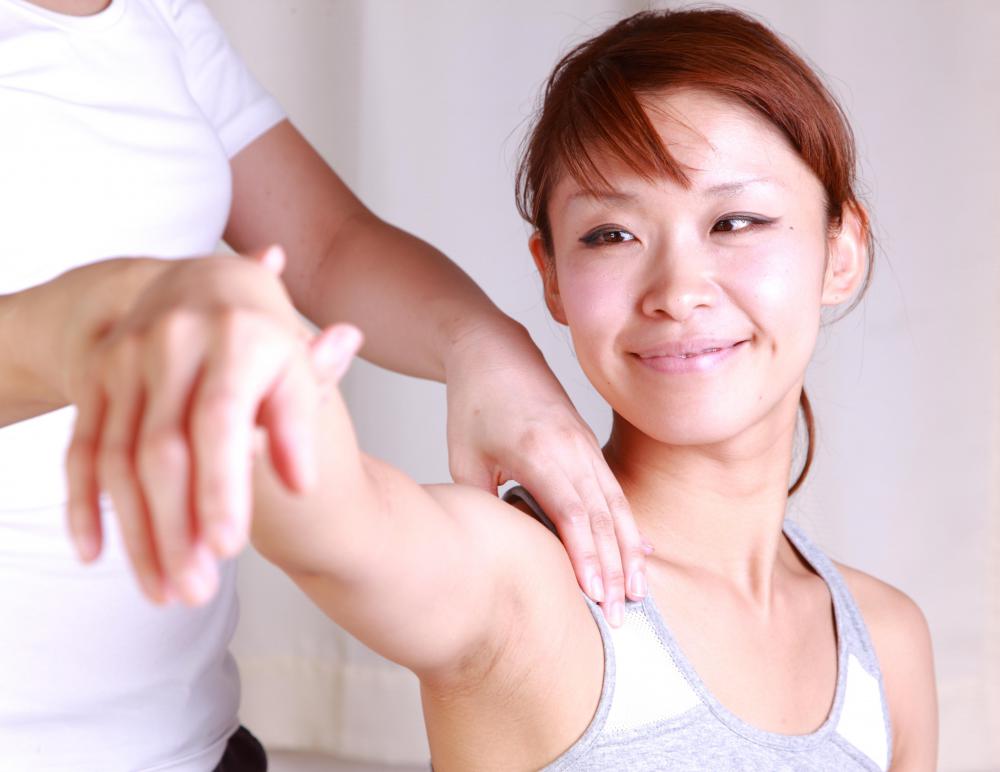At WiseGEEK, we're committed to delivering accurate, trustworthy information. Our expert-authored content is rigorously fact-checked and sourced from credible authorities. Discover how we uphold the highest standards in providing you with reliable knowledge.
What is Jin Shin do?
Jin Shin Do is a form of therapeutic massage. It was created in the 1970s by practitioner Iona Marsaa Teeguarden. This type of massage is in many ways built off of Jin Shin Jyutsu and is an integrative massage technique drawing heavily on various modalities of acupressure.
Physical pressure while patients are clothed, combined with energy work, and techniques culled from Ericksonian psychotherapy are used in Jin Shin Do to try to open up patients. The concept of armoring is referenced in this method, which has some similarities to the concept in Reichian Orgone therapy. The idea behind it is to help the patient realize an open flow of an energetic lifeforce, based on the Chinese idea of qi.

Jin Shin Do means "the Way of the Compassionate Spirit," and it is a non-judgmental modality that takes positive elements of many different forms of energy and body work to create a powerful healing technique. It focuses on set pressure points, and different techniques to relieve stress at those points, drawing from both Chinese and Japanese acupressure.

It is not an acupuncture technique, so there is never any needle contact in Jin Shin Do, or anything more than pressure exerted with the fingers. At the same time, it is a particularly light form of acupressure, and so can be contrasted with Shiatsu as well. The idea is to create a sympathetic, supportive feeling in the patient, and this is done in a slow, gentle manner, as opposed to Shiatsu’s more aggressive pressure.

Jin Shin Do uses a simple shortcut system to deal with various problems. Various flows are given, as sorts of recipes for energetic health, which can be easily followed by even home practitioners. There is an easy-to-understand 45 point system and a color-coded chart to make practicing it even easier. As a result, it is one of the easiest forms of acupressure for people to pick up and start doing, and many people practice it on an amateur basis with family or friends, or even on themselves. Since the pressure is relatively light, the risk of damage is incredibly low, so it provides a safe environment for experimenting with therapeutic massage.
Practitioners may be certified in two areas. The Category One practitioners have undergone a teacher certification program, and are ranked at one of three levels, either Basic, Intermediate, or Advanced. Category Two practitioners have undergone 250 hours of Jin Shin Do training, have logged at least 125 hours of real-world experience, have accomplished at least ten private sessions, and have completed a number of practical examinations.
AS FEATURED ON:
AS FEATURED ON:













Discussion Comments
First: I am a Senior Teacher of Jin Shin Do(R) Bodymind Acupressure(TM); also an acupuncturist who is trained in a variety of bodywork and counseling modalities.
There are a number of corrections I would like to submit to this article:
1. The pressure used in JSD is actually fairly firm, not light (although we can use light touch, and moderate the amount of pressure depending on the client and the specific point used at any time). The difference is that Shiatsu is much more "massage" like (i.e., mobile, tissue moving), while with JSD we stay at a point for a longer time than is typical in Shiatsu. Partly because of this sustained stationary pressure, we are often able to have the muscles relax more deeply, with less work.
2. "Jin Shin Do uses a simple shortcut system..." Yes and no - in the first classes, we teach "recipes" to address a wide variety of situations, as well as teaching how to choose and combine points to customize treatments for clients. As students progress, they gain a greater repertoire of points and techniques.
The recipes learned in the first classes are extremely effective - I still use them quite frequently, because they are so effective.
3. The first class teaches 55 points - not 45.
4. Even though we don't use an "incredibly light" pressure, the risk is still very low, and it is easy to practice. I've taught people in wheelchairs, teenagers, truck drivers, retirees, etc. - and while some go on to complete the full Practitioner Certification program, the vast majority of people use these techniques for portable, anytime use with family and friends.
5. "have accomplished at least ten private sessions..." This means they have been on the receiving end of having at least ten sessions - so they know what it feels like to be a client. The 125 hours are sessions they have given to clients, demonstrating their progress.
I encourage you to call and talk with a Jin Shin Do practitioner or teacher to answer any questions you may have.
Post your comments